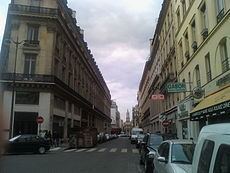Quarter Chaussée-d'Antin Denomination 1712 | Inaugurated 1712 | |
 | ||
Arrondissement | ||
This "quartier" of Paris got its name from the rue de la Chaussée-d'Antin in the 9th arrondissement of Paris. It runs north-northwest from the Boulevard des Italiens to the Église de la Sainte-Trinité.
Contents
Map of Rue de la Chauss%C3%A9e d'Antin, 75009 Paris, France
In the 17th century the chemin des Porcherons crossed a swampy piece of ground north of the porte Gaillon, a city gate in the wall built during the reign of Louis XIII, leading to the village of Les Porcherons. It is called a chaussée because the marshy ground required raised construction that ran along the top of a sort of dyke.
At the rue de Provence it crossed the "great sewer" or Ruisseau de Ménilmontant, which was approximately two meters wide.
Under an ordinance dated 4 December 1720, the street was graded and resurveyed as a wider boulevard with a width of eight toises and extended to meet the grands boulevards to the south. This new boulevard stretched from the end of Rue Louis-le-Grand to Rue Saint-Lazare.
The frequent stays of Louis XV in Paris led him to build splendid homes such as that of Louis Antoine de Pardaillan de Gondrin, the Duke of Antin (1665–1736). Son of the marquise de Montespan, the duke was the superintendent of the Bâtiments du Roi, or buildings of the king. His residence faced this street and his name became associated with it as early as 1712.
Notable places
At the intersection of the Boulevard des Capucines, stood the former hôtel de Montmorency, which gave way to the Théâtre du Vaudeville in 1869, and then the Paramount Opéra cinema theater in 1927. The main hall of the theater corresponds to the 'grand salon' -- probably a ballroom—of the 18th-century hôtel. The rotunda above the facade has been preserved.
The notorious Cabaret de la Grande Pinte stood on the present site of the Église de la Sainte-Trinité. It opened in 1724, and could accommodate 600 people for public festivities.
At the intersection of the Boulevard des Italiens stood the barracks of the Gardes Françaises, or French guard barracks, built by the Duke of Biron in 1764. It gave the boulevard its name for some years. On 12 July 1789, a platoon of the guards saved his colonel, M. Duchâtelet, from popular riots.
The air was thought to be healthier to the north and west of Paris during the 18th century. That, and the higher ground, attracted the upper classes. A series of glamorous hôtels particuliers were erected along the Chaussée-d'Antin in the later 18th century (now destroyed) :
In 1977, 400 pieces of sculpture, from the facade of the cathedral Notre Dame de Paris, were found underground of the hôtel Moreau. Especially heads of the kings of Juda. During the French revolution, the statues were destroyed because people thought that they were statues of kings of France.
During the 19th century commercial establishments changed the character of the street, and shops opened in the ground floors of the old residences. For Honoré de Balzac "The heart of Paris today beats between rue de la Chaussée-d'Antin and rue du Faubourg Montmartre." In 1840 the street was extended past rue Neuve-Saint-Augustin. The first one-way streets in Paris were the Rue de Mogador and the Rue de la Chaussée-d'Antin, created on 13 December 1909.
